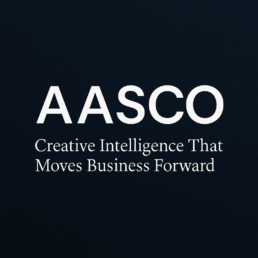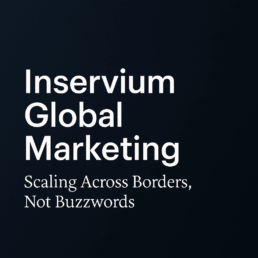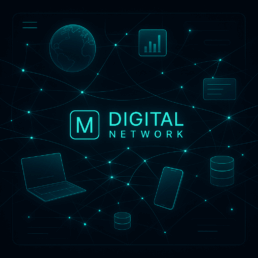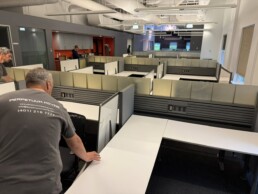AASCO - Marketing Company Based in Moldova
AASCO - Ahead Advertising Solutions Company
Creative Intelligence That Moves Business Forward
Some agencies design logos.
Some run ads.
Some sell templates.
We don’t do any of that.
At AASCO, we build decision-making systems for modern brands.
Not services — strategic intelligence, expressed through design, marketing, and clarity.
We’re not an agency.
We’re the creative core of a growth infrastructure.
What AASCO Actually Is
AASCO is the flagship creative and marketing company in the GDSN ecosystem.
But our role goes far beyond branding.
We:
-
Design brand identities that align with business direction
-
Architect campaigns that drive qualified demand
-
Build marketing funnels with performance logic
-
Craft narratives that anchor your brand in the minds of clients
-
Integrate design, psychology, and revenue strategy into one system
Everything we do is rooted in one principle:
If it doesn’t move the business forward, we don’t build it.
Why We Created AASCO
Because most marketing today is disconnected and improvised.
Founders jump between:
-
A freelancer for the website
-
A designer for the logo
-
A media buyer for ads
-
A consultant for strategy
But no one sees the whole picture.
We built AASCO to solve that.
One company, one logic, one voice — from idea to execution.
We operate like a creative operating system for businesses who don’t want to guess anymore.
The AASCO Approach
Every AASCO project follows a principle:
Psychology first, design second.
We begin with:
-
Audience and industry research
-
Competitive positioning and emotional mapping
-
Business model review
-
Visual system planning
-
Funnel and campaign architecture
Only then do we design.
Only then do we launch.
We treat marketing like engineering:
Structure → Blueprint → Build → Iterate → Scale.
No fluff. No guesswork. No templates.
Our Core Disciplines
1. Strategic Branding
We define brand cores, value statements, visual identities and verbal architecture — always tied to business outcomes.
2. Performance Marketing
Google Ads. Meta Ads. Local SEO. Landing pages that convert. Campaigns that feed sales — not likes.
3. Creative Design
Websites, identities, pitch decks, packaging. Everything clean, coherent, and conversion-driven.
4. Campaign Systems
We build multi-touchpoint systems with automation, CRM integrations and full-funnel visibility.
5. Partner Ecosystem
As part of GDSN, AASCO collaborates natively with M Digital Network and Inservium for technical and international execution.
Who AASCO Is For
AASCO works with:
-
Founders tired of scattered marketing
-
Service businesses that want clarity and results
-
Product companies seeking deep market resonance
-
Municipalities and public organizations that need professional positioning
-
Agencies looking to scale with a strategic partner
If you want gimmicks, we’re not for you.
If you want structured growth with elegance, intelligence, and logic — let’s talk.
Our Design Language
Inspired by:
-
Apple’s clarity
-
Notion’s calm
-
TBWA’s precision
-
Strategic psychology
Our work looks clean — but it’s deep.
No clutter. No noise.
Just decisions made visible.
AASCO Within GDSN
We are the creative engine of the GDSN structure:
-
Inservium handles global marketing logic
-
M Digital Network builds the systems and CRM tech
-
MCHS runs the infrastructure and hosting
-
AASCO builds the interface between you and the world
We make sure that what you say, what you show, and what you offer —
all speak the same truth.
Final Words
You don’t need another campaign.
You need a system that understands your business and expresses it precisely.
That’s what we build at AASCO.
Because in today’s market, the difference between growth and stagnation
is how clearly your message lands.
Inservium Global Marketing
Scaling Across Borders, Not Buzzwords
In a world obsessed with “global expansion,” most marketing agencies are still trapped in local thinking dressed up in international packaging.
They speak in buzzwords.
They sell vanity metrics.
They tell you to “go global” — but they can’t even handle multilingual strategy or ad distribution outside their own timezone.
That’s why Inservium exists.
Not to impress.
To scale — intelligently, strategically, and sustainably.
What Is Inservium?
Inservium Global Marketing Company is our international marketing division.
But it is not a “global agency” in the traditional sense.
It’s a cross-border acceleration system built for:
-
B2B companies with technical or service-based offerings
-
Local businesses looking to expand regionally
-
Public institutions with multi-language audiences
-
Digital entrepreneurs with scalable products
-
Educational and consultancy platforms with international scope
Inservium is designed for clarity, not clutter.
It replaces generic outreach with researched, multilingual, conversion-oriented execution.
What We Saw Before We Built It
We worked with too many businesses that had:
-
A great product that sold in one country and failed silently in the next
-
“International” campaigns run by agencies that couldn’t localize tone or logic
-
Landing pages translated with Google, but lacking cultural context
-
Budgets spent on reach with no qualified leads in return
It became clear:
Going global isn’t about wider reach.
It’s about deeper relevance in multiple contexts.
That’s what Inservium was built to solve.
What We Actually Do
We don’t run ads and hope.
We build layered marketing systems designed for cross-border traction.
We operate in English, Romanian, French, and Russian — not just as languages, but as cultural layers.
We plan, execute and optimize campaigns across Europe and beyond with localized infrastructure and narrative adaptation.
Here’s how:
-
Strategy and content development by region and audience type
-
Advertising campaigns across Google, Meta, LinkedIn, YouTube and more
-
Dedicated landing pages, funnels and automation flows per geography
-
CRM integration, lead capture, and follow-up customized by market
-
Performance tracking based on qualified outcomes, not just impressions
Every country has its own emotional logic.
Every city has a timing pattern.
Every audience has a decision trigger.
We map them all — then we deploy.
Who It’s For
Inservium works with founders, marketing teams and institutions that:
-
Need structure, not slogans
-
Operate in multiple countries and want a single, consistent system
-
Sell services or high-trust products that can’t rely on mass ads
-
Value message clarity over flashy visuals
-
Want results across borders without losing their core identity
We don’t offer shortcuts.
We offer scalability — real, structured, and managed.
We Don’t Sell Exposure
Exposure without logic is expensive noise.
Most “global” agencies sell traffic, not traction.
We build systems that give you:
-
Presence that translates into real inquiries
-
Visibility that’s backed by trust
-
Marketing messages that land, not just display
-
Strategic clarity that can be repeated, scaled, and improved
You don’t need more followers.
You need architecture.
Part of the GDSN Ecosystem
Inservium doesn’t work alone.
It operates as part of the Global Digital Solutions Network (GDSN) — a full-stack ecosystem designed for autonomy and structured growth.
-
AASCO provides the creative and strategic positioning
-
M Digital Network builds the CRM, automation and backend logic
-
MCHS powers the infrastructure with private hosting across regions
-
GDSN connects it all legally, financially and structurally
This is why our cross-border work isn’t just translated — it’s engineered.
Final Words
Crossing borders with your brand is no longer about translation and hope.
It’s about building a logic that travels.
That’s what Inservium is here to do.
For companies that don’t want to just appear in new markets —
but build presence, consistency, and impact within them.
Why We Build What We Build
The Human Code Behind AASCO, M Digital Network, and the Global Engine We Call GDSN
At first glance, we’re just a marketing agency. Or a digital network. Or maybe a cloud infrastructure company.
But if you look closer, you’ll see a pattern.
A logic. A design.
A living system made not of code and servers — but of conviction.
We build systems that other companies build on.
We design strategies that ignite business direction.
And we don’t do it randomly.
We do it because the world is too full of noise, promises, and sterile “solutions” that don’t connect.
❍ So, What Exactly Do We Do?
We operate multiple brands — each focused, specialized, but interconnected like organs in a single body:
-
AASCO Marketing – Branding, campaigns, design, and positioning for companies that need more than just visibility — they need meaning.
-
M Digital Network – A backbone for modular software, cloud services, infrastructure and systems that businesses run on.
-
Iservium Global Marketing – Strategic reach across borders. Built for scaling impact across geographies.
-
GDSN (Global Digital Solutions Network) – The holding ecosystem that legally and structurally supports every initiative we launch.
And together, these are not just business lines.
They are interfaces between vision and execution.
We Don’t “Offer Services.”
We Build Control Systems for Founders Who Want Autonomy.
Most founders don’t want more tools. They want more clarity.
They don’t need another CRM — they need a system that adapts to how they think.
That’s where we come in.
We build marketing, branding, CRM, ERP, cloud, hosting and digital infrastructure in one logical architecture.
So your startup doesn’t depend on 17 tools and 6 freelancers — just one ecosystem, made for growth.
We don’t pitch you apps.
We engineer business independence.
Why We Started: Because We Were Tired of Improvising
We’ve been through the sleepless nights, the unstable cash flow, the broken client funnels.
We’ve worked with clients who were juggling:
-
A slow Wix site
-
An underperforming Facebook page
-
A CRM that didn’t speak to the sales team
-
Ads that burned budgets but not leads
So we said: What if we design an ecosystem where everything speaks the same language?
Where:
-
Marketing isn’t just design — it’s a growth command center
-
Infrastructure isn’t rented — it’s owned and optimized
-
Clients don’t just get “work” — they get partnership logic
We called that vision GDSN.
We gave it operational arms: AASCO. M Digital Network. Iservium.
And we went to work.
We Are Not a Product of AI
But We Work With It — On Our Terms.
Let’s be real: most blog posts these days sound like they were written by ChatGPT.
This one wasn’t.
This is a founder speaking.
A builder. A strategist. A fighter.
We use AI like we use code, servers or psychology:
To create leverage, not illusions.
We’re not here to fake depth.
We’re here to build it.
What Makes Us Different?
🛠 We build systems, not services
Everything is modular, upgradable, and connected — from your lead gen to your invoices.
⚙️ We offer full-cycle control
Design → infrastructure → marketing → automation. Done in-house, no outsourcing chaos.
🧠 We think like entrepreneurs
We don’t pitch ideas. We map opportunities, calibrate strategy, and execute with discipline.
🌍 We’re structured for scale
Whether you’re in Romania, France, Moldova, the U.S. — our systems are built to cross borders and multiply impact.
For the Client Reading This:
You don’t care how fancy our logos are.
You want results. Clarity. Direction. Predictability.
You want systems that save you time, money, and mental load.
That’s what we do.
We sit down.
We map everything: your business model, your goals, your obstacles, your energy.
Then we build the machine around you, not the other way around.
What’s Next?
If you’re a company that wants to:
-
Build a brand that cuts through noise
-
Set up a CRM that actually fits your team
-
Automate your client flow
-
Or scale from local to regional with a system that won’t collapse
Then don’t call us for a quote.
Call us for a strategy session.
Let’s map out what’s broken — and build what works.
Final Words
We didn’t build AASCO or M Digital Network just to make money.
We built them to gain freedom.
Now, we help others do the same.
Whether you’re a startup, an agency, a production company, or a municipality — if your growth depends on clarity, precision, and infrastructure, we should talk.
Let’s design your freedom system together.
Written by someone who actually builds these systems.
Not an AI. Not a marketer on autopilot.
Just someone who believes in digital infrastructure that works because it’s human at the core.
How to Choose the Right Moving Company — Not Just the Cheapest One
A complete guide to asking the right questions, spotting red flags, and hiring movers you can actually trust.
Price Isn’t Everything
When planning a move, it’s natural to look at cost. But choosing a mover based only on the lowest quote can lead to costly mistakes. The wrong team can cause delays, damage, stress, and miscommunication.
At Perpetuum Moving, we believe informed clients make better decisions—and ultimately enjoy smoother, more successful moves. Here’s what you need to consider before booking any moving company.
Transparent Pricing, No Hidden Surprises
A reputable company provides a written estimate that clearly outlines the structure of the price. That should include:
-
The hourly rate or flat fee
-
Charges for travel time and fuel
-
Labor or equipment fees
-
Any additional services like packing, hoisting, or storage
If a quote seems vague or suspiciously cheap, there’s likely more to it. Lowball offers often come with hidden charges that surface later. A professional team will walk you through the estimate and explain each cost with clarity.
Licensing and Insurance Matter
Moving isn’t just a matter of logistics—it’s a matter of liability and compliance. Before you commit, make sure the company:
-
Has a valid DOT number (for interstate moves)
-
Is fully insured with general liability and cargo coverage
-
Can provide a Certificate of Insurance (COI) if required by your building
This protects you in case of damage, loss, or accidents—and ensures you’re hiring a legitimate operation, not a side gig with a rented truck.
Experience with Your Type of Move
Not all movers are built for every type of job. Your specific situation may require more than just muscle. Make sure the team has relevant experience in areas such as:
-
Narrow staircases, elevator buildings, or tight hallways
-
High-value items like artwork, antiques, pianos, or custom furniture
-
Office relocations or commercial moves with strict timing
-
Long-distance logistics that require coordination and punctuality
At Perpetuum Moving, we specialize in efficient, complex moves—residential or commercial—with over 20 years of hands-on experience to back it up.
Professional Communication from Day One
You should feel confident from your very first interaction with a moving company. How they communicate before the move is a strong indicator of how they’ll perform on moving day.
Look for:
-
Timely responses to your calls or emails
-
A clear explanation of the process and what to expect
-
A respectful, professional tone throughout the conversation
-
Flexibility and transparency regarding scheduling and logistics
Pay attention to how your questions are received. If they’re dismissive now, things won’t get better later.
Real Reviews, Real Reputation
Online reviews and recommendations matter. Before you sign a contract, do a bit of digging:
-
Check their Google reviews and third-party ratings
-
Look at how they respond to both positive and negative feedback
-
Ask for references or proof of past work, especially for complex jobs
-
Look for consistency in professionalism and reliability
A strong reputation is built over time—and reflects how a company handles real-world situations, not just polished sales pitches.
No Pressure Tactics
You should never feel rushed into a decision. A trustworthy moving company will give you time to review the quote, consult your schedule, and make an informed choice.
If someone is pushing you to book immediately, avoiding written confirmations, or using urgency as a sales tactic, take that as a red flag.
Clear Terms for Deposits, Cancellations, and Rescheduling
Before you commit, make sure the company explains:
-
Whether a deposit is required—and if it’s refundable
-
What happens if you need to change your moving date
-
If there’s a formal contract with clear terms and responsibilities
At Perpetuum Moving, we always provide written agreements and transparent terms. Our clients never wonder what they’ve agreed to—and that makes a difference when things get busy.
Final Thought
Moving is one of the most personal services you can hire. You’re placing everything you own—everything that makes up your home—into someone else’s hands. That’s not a decision to take lightly.
Don’t settle for the cheapest option. Choose the team that makes you feel confident, respected, and supported—every step of the way.
Need a quote or want to talk through your options?
Contact us today and let’s plan your move with precision.
You Don’t Have to Invent What Already Exists
You Don't Have to Invent What Already Exists: The Game-Changing Mindset for Success
In our relentless pursuit of innovation and originality, we often fall into a costly trap: believing that success requires us to reinvent the wheel. This mindset has paralyzed countless entrepreneurs, creators, and professionals who waste precious time and energy trying to create something entirely new when they could be building upon proven foundations.
The Myth of Total Originality
Our culture celebrates the myth of the lone genius who creates something completely unprecedented. While this makes for inspiring stories, it's rarely how real success works. The truth is, most breakthrough innovations are actually clever adaptations, combinations, or improvements of existing ideas.
Consider these examples:
- Facebook didn't invent social networking – it perfected it
- Uber didn't create ride-sharing – it revolutionized how we access it
- Apple didn't invent the smartphone – it reimagined what one could be
- Netflix didn't create video streaming – it transformed the experience
Why Reinventing Is Often a Mistake
1. Wasted Resources
When you try to build everything from scratch, you're essentially burning time, money, and energy that could be better invested in execution and improvement.
2. Proven Market Demand
If something already exists and thrives, there's clear evidence of market demand. You don't need to guess – you know people want it.
3. Learning from Others' Mistakes
Existing solutions have already gone through trial and error. You can learn from their failures without experiencing them yourself.
4. Faster Time to Market
Building on proven concepts allows you to launch faster and start generating revenue sooner.
The Smart Approach: Build, Don't Invent
Study What Works
Research successful examples in your field. What makes them work? What problems do they solve? What gaps still exist?
Identify Improvement Opportunities
Look for ways to make existing solutions:
- Faster
- Cheaper
- More convenient
- Better designed
- More accessible
- More personalized
Add Your Unique Value
This doesn't mean copying – it means taking what works and adding your unique perspective, skills, or improvements.
Real-World Applications
For Entrepreneurs
Instead of trying to create a completely new business model, find a successful one and ask: "How can I do this better for my specific market?"
For Content Creators
Rather than struggling to find entirely original topics, take proven content formats and add your unique voice and perspective.
For Professionals
Look at what successful people in your field are doing. What systems, processes, or strategies can you adapt and improve?
For Problem Solvers
When facing a challenge, research how others have solved similar problems. Adapt their solutions to your specific context.
The Innovation Paradox
True innovation often comes from combining existing ideas in new ways, not creating something from nothing. The iPhone wasn't revolutionary because it was completely original – it was revolutionary because it combined existing technologies (touchscreen, internet, phone, music player) in a way no one had done before.
Overcoming the "Not Invented Here" Syndrome
Many people resist using existing solutions because of pride or the belief that they need to prove their creativity. This "Not Invented Here" syndrome can be career-limiting. Instead:
- Embrace standing on the shoulders of giants
- Focus your creativity on improvement, not invention
- Measure success by results, not originality
- Remember that adaptation is a form of intelligence
When to Actually Invent Something New
There are times when creating something entirely new makes sense:
- When existing solutions genuinely don't address a real problem
- When you have access to new technology that enables better solutions
- When market conditions have changed dramatically
- When you have deep expertise that reveals fundamental flaws in current approaches
Practical Steps to Implement This Mindset
1. Research Phase
- Study your competition thoroughly
- Identify the most successful players in your space
- Analyze what makes them successful
2. Gap Analysis
- Where are current solutions falling short?
- What do customers complain about?
- What improvements would create significant value?
3. Adaptation Strategy
- How can you take the best elements and improve them?
- What's your unique angle or advantage?
- How will you differentiate while building on proven foundations?
4. Execution Focus
- Spend 80% of your energy on execution, 20% on innovation
- Test and iterate quickly
- Focus on solving real problems better than anyone else
The Competitive Advantage of Smart Adaptation
Companies and individuals who master the art of intelligent adaptation often outperform those obsessed with total originality because they:
- Move faster to market
- Reduce risk by building on proven concepts
- Can focus resources on execution rather than validation
- Learn from others' expensive mistakes
Conclusion: Success Loves Shortcuts
The most successful people and companies understand that there's no shame in building upon what already works. In fact, it's often the smartest strategy. Your goal shouldn't be to prove how original you can be – it should be to solve problems better than anyone else.
Remember: Innovation isn't about creating something that has never existed. It's about creating something that works better than what currently exists.
The next time you catch yourself trying to reinvent the wheel, ask yourself: "How can I make this wheel roll better?" That's where real success lies.
Stop trying to prove you're creative by starting from zero. Start proving you're smart by building on the successes of others. Your future self will thank you for choosing progress over pride.
Why You Can’t Think Clearly Anymore
Mental noise, digital overload, and the slow erosion of clarity
Introduction
You’re not lazy.
You’re not broken.
Your mind is just drowning—and no one taught you how to breathe.
We used to have space.
To think. To drift. To reflect.
Now?
Each second is filled—notifications, conversations, tabs, tabs, tabs.
You haven’t lost clarity.
You’ve just never had silence long enough to hear it.
The Modern Brain Is Not Designed for This
-
Dopamine loops destroy sustained focus.
-
Context-switching breaks neural flow.
-
Sleep is light. Input is constant.
And you’re expected to function like a machine.
The Real Problem Is Noise Without Meaning
Not all information is knowledge.
Not all connection is presence.
You are overstimulated, not overworked.
And the difference is the key to healing.
Solutions That Don’t Sound Like Tech Detox
-
Reclaim the first hour of your day. No phone. No input. Just presence.
-
Write your brain out. A page a day. No editing. Just unloading.
-
Practice focused boredom. One hour a week. No task. Just stillness.
Your brain isn’t a hard drive.
It’s a forest. Let it breathe.
Closing Thought
Clarity isn’t something you get.
It’s something you remember—once the noise fades.
The Quiet War of the Self-Made
Why Building a Business Often Feels Like Breaking Yourself First
The Lie We All Believed
“Be your own boss.”
“Work from anywhere.”
“Make money while you sleep.”
You’ve heard it. We all have.
But no one talks about the silent war inside those who actually try to do it.
-
The sleepless nights.
-
The self-doubt masked as motivation.
-
The days where quitting feels easier than coffee.
What Success Looks Like Behind Closed Doors
Q: So what does success really feel like?
A: Sometimes… it feels like nothing.
-
You hit the goal, but you’re already chasing the next.
-
You land a big client, but it doesn’t fix the hole inside.
-
You smile on LinkedIn, but you’re silent at home.
Why?
Because we’ve confused growth with peace.
And achievement with healing.
The Loneliness No One Talks About
You’re surrounded by people – team, clients, followers – and yet… you’re alone.
-
You can’t complain. They think you’re winning.
-
You can’t break down. You’re the “pillar.”
-
You can’t ask for help. You are the help.
So you burn. Quietly. Elegantly.
Until you stop feeling it.
The False Savior: “Just Hustle More”
Somewhere along the road, hustle became a religion.
But pushing harder doesn’t solve what’s broken inside.
-
Your fatigue is not laziness.
-
Your brain fog is not weakness.
-
Your desire to disappear for a day… is not failure.
You are not broken. You are overloaded.
And there’s a difference.
Three Things I Wish Someone Had Told Me at the Start
1.
You won’t feel like a winner. And that’s normal.
Growth feels like chaos before it feels like clarity.
2.
You’ll lose some friends.
Not because you changed.
But because they needed you to stay the same.
3.
You’ll find peace in strange places.
Like 3AM journaling.
Or cleaning your desk after a failed pitch.
How to Lead Without Losing Yourself
Want to survive this long-term? Start here:
-
Build inner rituals, not just morning routines.
-
Talk to one person who doesn’t care about your business – but cares about you.
-
Let go of the image. Grow the core.
Don’t brand yourself as strong.
Build yourself to be soft where it matters.
The Real Currency of Entrepreneurs
It’s not money. Not influence.
It’s clarity. The ability to say:
“This is what I want. This is what I refuse. And this is who I’ll be – even if I lose it all.”
That’s what makes you powerful.
And dangerous.
And real.
Final Words
You don’t need to look unstoppable.
You need to be unshakeable – even when you’re still figuring it out.
The quiet war never ends.
But over time, you learn to fight with yourself, not against it.
Real Stories from Real Moves
What You Pack Isn’t Always What You Carry
Why Moving Isn’t Just About Furniture
When you’re moving, people see boxes. Labeled, sealed, efficient.
But inside those boxes? Years of memories.
And outside of them? A person who’s silently going through a storm.
What We Don’t Talk About: The Emotional Cost of Relocation
“I didn’t expect to cry when I took down that last photo.”
Sound familiar?
-
You’re not just changing homes – you’re leaving a version of yourself behind.
-
You begin to remember your first evening in the old place… and suddenly, it’s your last.
-
What seems like logistics often feels like grief.
Case File: The Man Who Moved After a Divorce
He called a moving company.
He didn’t mention the divorce. He didn’t have to.
His face, his silence, his way of looking at the hallway spoke enough.
The team carried out furniture, but what lingered was pain.
We didn’t pack the wedding album. He already burned it.
Interview: “I’ve Seen People Break in Hallways.”
A mover speaks:
“Sometimes I see a grown man sit on a cardboard box and just… stop.
Not from exhaustion. From memory.”
-
Movers aren’t just workers. They become silent witnesses.
-
They feel the energy of a space. The echoes. The goodbye left unsaid.
The Psychology of Transition: What Really Happens?
Moving disrupts your nervous system.
You go through unstructured grief: no funeral, no ceremony – just a van and a signature.
-
Your brain loses visual anchors. That wall you saw every morning? Gone.
-
Your sense of identity, oddly tied to space, begins to shift.
-
You feel out of place – even in your new place.
How to Carry the Invisible Luggage
Here’s what helps – and it’s not bubble wrap:
-
Say goodbye out loud. Even if no one hears you. It makes it real.
-
Keep one item unboxed until the last second – something meaningful.
-
Write a short note to your old self before you move. Fold it. Leave it.
-
Create a small ritual for the new home. Light. Sound. Smell. Something that grounds you.
Final Words
You’re not weak for feeling.
You’re not “too attached” for needing time.
You’re not moving just things. You’re moving parts of yourself.
And it’s okay if it takes a while to arrive – even after the boxes are in.







